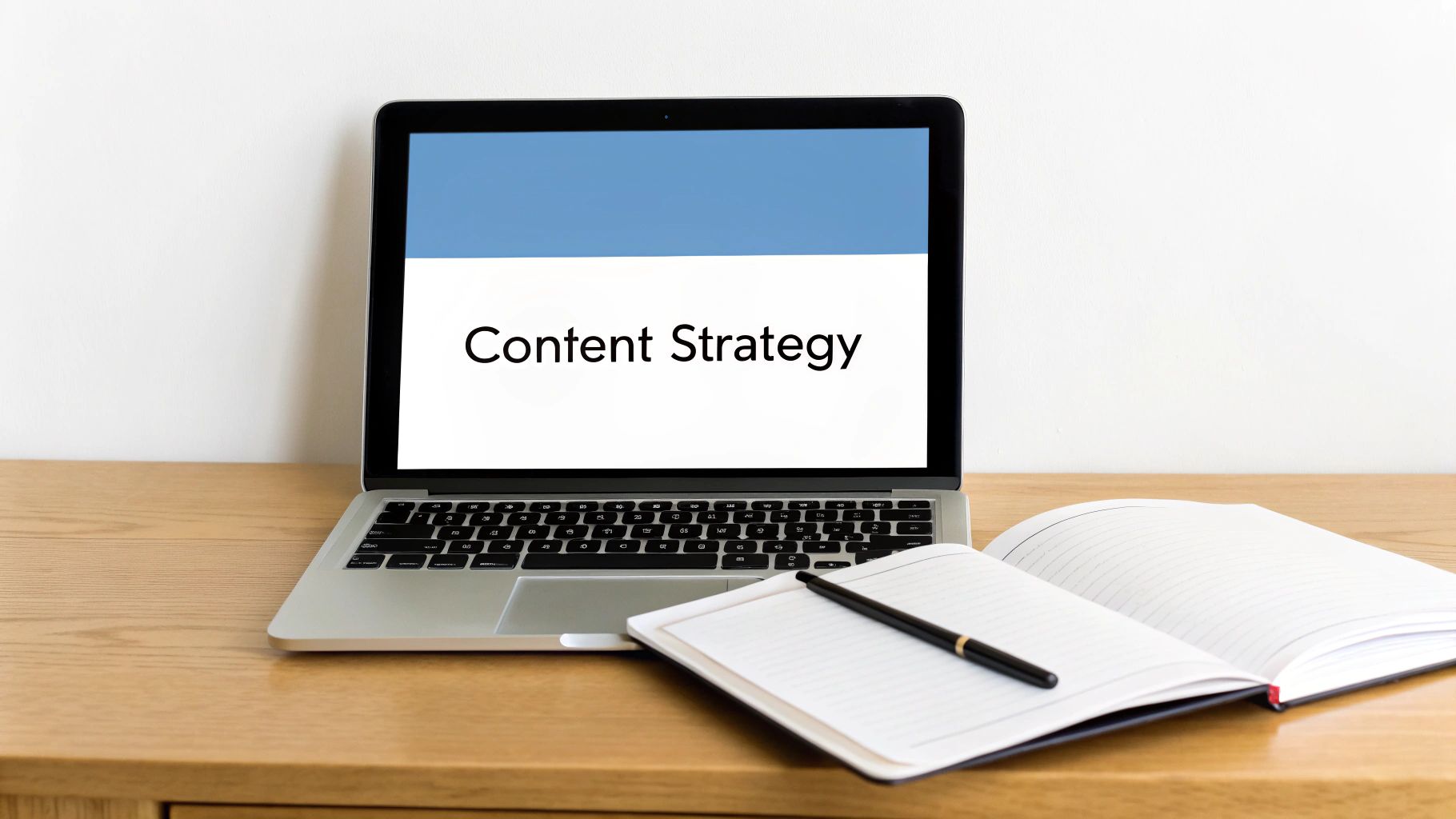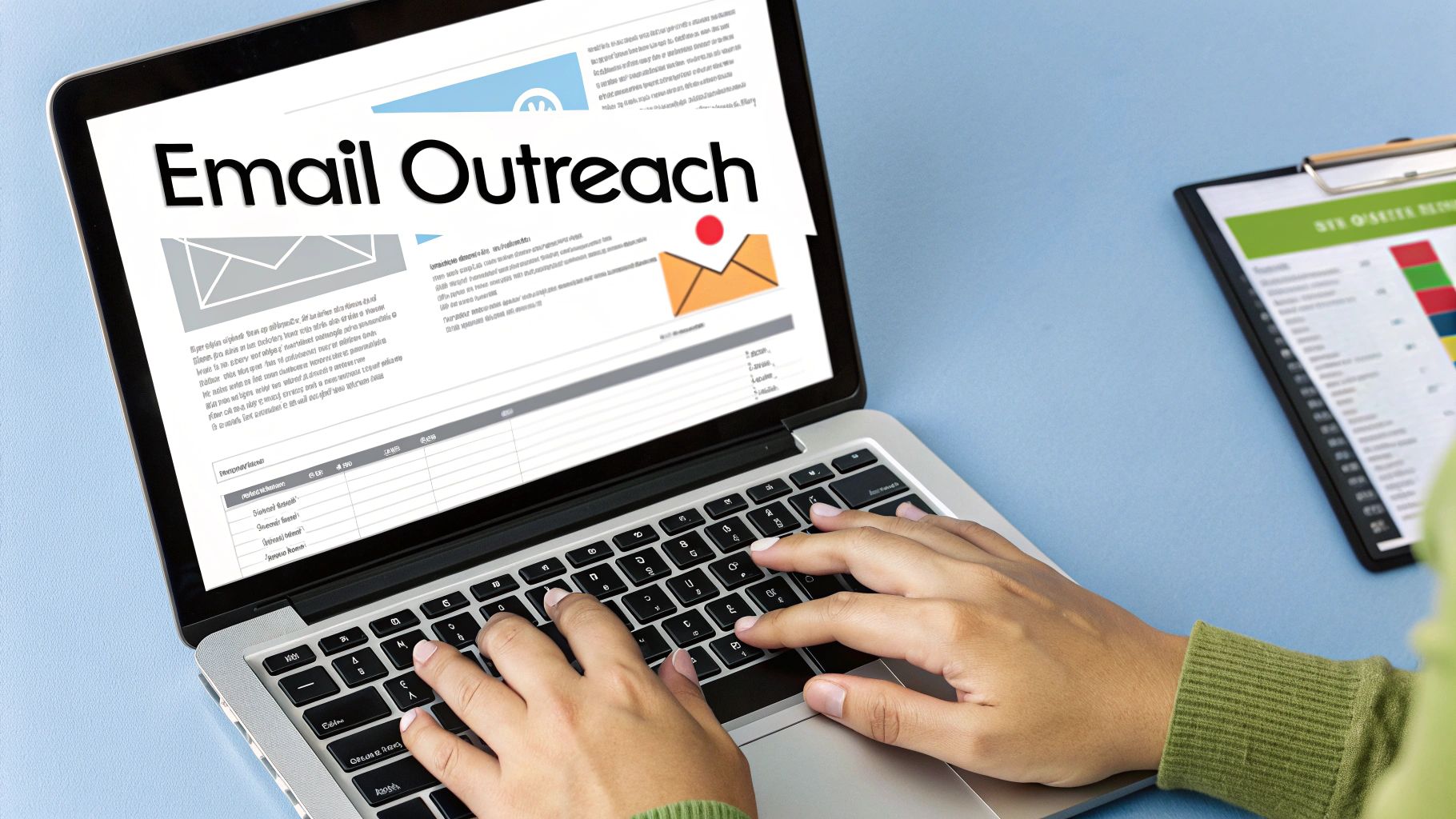Feeling swamped by the endless marketing options for your small business? You're not alone. In a world of ever-changing algorithms and trends, finding effective, budget-friendly ways to reach your customers can feel like searching for a needle in a haystack. Many entrepreneurs think powerful marketing needs a massive budget, but that’s simply not true. The key is to be smart about it, focusing your energy on proven tactics that deliver a real return on your time and investment.
This guide cuts through the noise to give you a clear roundup of powerful and practical small business marketing strategies designed for real-world results. We're skipping the generic advice and focusing on what actually works. You'll find step-by-step guidance on everything from mastering social media and local SEO to building a loyal customer base through referrals and email marketing. We’ll explore how to create content that connects, build valuable partnerships, and even use unconventional methods to stand out from the competition.
Whether you're a plumber in Portsmouth, a freelance designer in Glasgow, or running a popular TikTok Shop from your spare room, this article is your blueprint. Each strategy is broken down into simple steps, offering fresh ideas you can put into action immediately to build brand awareness, engage your community, and drive steady growth. Forget the complex jargon and abstract theories; this is about giving you the tools you need to connect with your audience and hit your business goals. Let's get started.
1. Harnessing WhatsApp Business for Direct Customer Engagement
Forget complex email campaigns for a moment. One of the most effective small business marketing strategies today is to meet your customers where they already are: on WhatsApp. WhatsApp Business turns a simple messaging app into a powerful tool for direct, conversational marketing, letting you build genuine relationships and provide top-notch customer service.
This approach works because it’s personal. Unlike a formal email, a WhatsApp message feels immediate and familiar, building a level of trust that other channels struggle to replicate. By setting up a dedicated business profile, you can provide instant support, share updates, and even handle sales directly within a chat.
How to Implement This Strategy
Getting started is simple. First, give your business a professional touch by getting a dedicated virtual number. A service like Business Numbers Direct allows you to get a UK-based virtual number for as little as £7.99 per month, which keeps your personal number private and gives your business a more established, credible look without needing a second phone.
Next, focus on building an engaged contact list. Actively promote your WhatsApp number on your website, social media bios, and even on your business cards. Encourage customers to opt-in for exclusive updates or direct support.
Actionable Tips for Success:
- Complete Your Profile: Fill out every section of your WhatsApp Business profile, including your address, business hours, and a link to your website. This acts as a digital business card and builds instant trust.
- Master Quick Replies: Save time by creating templated answers for frequently asked questions (FAQs), such as your pricing, availability, or delivery options.
- Organise with Labels: Use the labelling feature to segment your contacts. You can create labels like ‘New Lead’, ‘Order Placed’, or ‘Loyalty Member’ to track customers on their journey and personalise your messages.
- Use Broadcasts Wisely: Share exclusive offers, new product alerts, or helpful tips with your broadcast lists. Remember, this is a privilege, not a right; always provide value and avoid spamming your audience to keep them engaged.
2. Establishing Authority with Content Marketing
Instead of just selling, what if you could become the go-to resource for your ideal customers? This is the heart of content marketing, a powerful small business marketing strategy focused on creating and sharing valuable, relevant information. By consistently providing helpful content, you build trust, establish yourself as an expert, and attract a loyal audience that eventually turns into paying customers.
This approach works because it prioritises helping over hyping. When a potential customer searches online for a solution to their problem, your blog post, guide, or video is there to help them. This act of providing value positions your brand as a credible authority, making you the natural choice when they're finally ready to buy.

How to Implement This Strategy
The first step is to really understand your audience’s problems. What questions are they always asking? What challenges do they need to solve? Your content should be the answer. A local accountant, for instance, could create blog posts explaining tax deadlines for sole traders, while a plumber could produce short videos on how to fix a leaky tap.
Next, choose a format you're comfortable with. If you're a great writer, start a blog. If you're more charismatic on camera, YouTube or TikTok might be your best bet. The key is consistency. Aim to publish new content on a regular schedule to build momentum and keep your audience coming back for more.
Actionable Tips for Success:
- Answer Customer Questions: Make a list of the top 10 questions customers ask you. Turn each answer into a detailed blog post, video, or social media update. This is the foundation of the "They Ask, You Answer" approach.
- Focus on Content Pillars: Identify 3-5 core topics related to your expertise. All your content should fall under these "pillars," creating a cohesive and organised hub of information that reinforces your authority.
- Repurpose Everything: Don’t let great content go to waste. A single blog post can be repurposed into a series of tweets, a short video script, an infographic, and an email newsletter segment. This maximises your reach with minimal extra effort.
- Use Keyword Research: Use free tools like Google Keyword Planner to find the exact phrases your audience is searching for. Create content that directly targets these keywords to improve your visibility in search results and attract the right kind of traffic.
3. Mastering Email Marketing for Customer Retention
In an age of fleeting social media trends, email marketing is still one of the most reliable and direct small business marketing strategies for building lasting customer relationships. It's like having a friendly conversation, allowing you to land directly in your customer's inbox with personalised messages, exclusive offers, and valuable content that keeps your brand top-of-mind.
Unlike social media algorithms that can limit your reach, your email list is an asset you own and control. This direct line of communication is perfect for nurturing leads, guiding them from initial interest to becoming loyal fans of your business. From a local bakery sending out weekly specials to an e-commerce store sharing personalised product recommendations, the possibilities are powerful and affordable.

How to Implement This Strategy
The first step is to build your email list the right way. You can't just buy a list; you need permission. Offer something valuable, known as a lead magnet, in exchange for an email address. This could be a discount on a first purchase, a free downloadable guide, or access to an exclusive webinar. Display this offer clearly on your website using pop-ups or forms.
Once you start collecting contacts, choose an email marketing platform like Mailchimp or ConvertKit to manage your subscribers and design your campaigns. These tools make the process easy, allowing you to create professional-looking emails and automate key communications without needing to be a tech wizard.
Actionable Tips for Success:
- Segment Your Audience: Don’t send the same message to everyone. Group subscribers based on their purchase history, interests, or how they signed up. This lets you send highly relevant content that connects better and drives more sales.
- Write Irresistible Subject Lines: Your subject line is your first impression. Keep it short, create curiosity, and avoid spammy words like ‘free’ or ‘buy now’. A great subject line dramatically increases the chance people will open your email.
- Automate Welcome Sequences: Create an automated series of emails for new subscribers. Use these to introduce your brand, set expectations, and provide instant value, building a strong relationship from day one.
- Always Include a Clear Call-to-Action (CTA): Every email should have a purpose. Whether you want them to ‘Shop Now’, ‘Read More’, or ‘Book a Consultation’, make your CTA button or link obvious and easy to click.
4. Search Engine Optimization (SEO)
Search Engine Optimization (SEO) is the process of getting your website to show up higher on search engines like Google—for free. By optimising your site and content, you can attract customers who are actively looking for the products or services you offer. For small businesses, this isn't just a technical task; it's one of the most powerful small business marketing strategies for generating a steady stream of high-quality leads without paying for every single click.
This strategy is fundamental because it builds a long-term asset. Unlike a paid ad that vanishes when your budget runs out, a well-ranked webpage can bring in traffic for months or even years. When a homeowner searches for ‘emergency plumber in Manchester’, SEO is what determines whether your business shows up on the first page or gets lost on the tenth.

How to Implement This Strategy
Start with a focus on local SEO, which is crucial if you serve a specific geographic area. The first and most important step is to create and fully optimise your Google Business Profile. This free listing is often the first interaction a potential customer has with your brand in local search results and on Google Maps.
Next, figure out the keywords your ideal customers are using. Think beyond broad terms like "bakery" and focus on more specific "long-tail keywords" such as "vegan birthday cakes near Bristol" or "best sourdough bread Hackney". These phrases have less competition and are used by people who are closer to making a purchase. Weave these keywords naturally into your website's pages, blog posts, and product descriptions.
Actionable Tips for Success:
- Claim and Complete Your GBP: Fill out every single section of your Google Business Profile: add photos, list all your services, post updates, and actively encourage customer reviews. This is non-negotiable for local visibility.
- Prioritise Website Performance: Make sure your website is mobile-friendly and loads quickly. Google favours sites that offer a good user experience, and a slow, clunky site will hurt your rankings.
- Create Genuinely Helpful Content: Start a blog and answer common customer questions. A plumber could write about ‘how to fix a leaky tap’, while an electrician might create a guide on ‘choosing energy-efficient lighting’. This positions you as an expert and attracts relevant search traffic.
- Build Local Citations: Get your business name, address, and phone number (NAP) listed consistently across relevant online directories like Yelp and Thomson Local. This reinforces your location and credibility to search engines.
5. Launch a Powerful Referral Marketing Programme
Instead of spending a fortune to find new customers, why not empower your happiest existing ones to do the work for you? That’s the idea behind referral marketing, a word-of-mouth strategy that gives people an incentive to recommend your business to their network. It's one of the most trusted and cost-effective small business marketing strategies you can use.
This approach is so effective because it taps into pre-existing trust. A recommendation from a friend or family member carries far more weight than a traditional ad, leading to higher-quality leads who are more likely to become customers. By creating a structured programme, you can turn casual recommendations into a reliable way to grow your business. Think of how Dropbox grew its user base by offering extra storage space for successful referrals.
How to Implement This Strategy
First, design a referral programme that is both attractive and simple. The easier it is for customers to refer someone, the more likely they are to do it. Decide on a compelling incentive for both the person referring and the new customer, creating a win-win scenario. This could be a discount, a cash reward, store credit, or exclusive access to a new product.
Next, make your programme visible. Promote it actively on your website, in email signatures, on social media, and after a customer makes a purchase. The key is to ask for a referral when the customer's satisfaction is at its peak, such as right after they’ve left a positive review or bought from you again.
Actionable Tips for Success:
- Offer Dual-Sided Incentives: Reward both the person making the referral and the new customer they bring in. For example, Airbnb offers travel credit to both parties, which encourages everyone to participate.
- Keep it Simple: The referral process should be effortless. Give customers a unique, shareable link or a simple form. The fewer steps involved, the more people will take part.
- Promote Across All Channels: Don't hide your referral programme. Feature it on your homepage, in post-purchase emails, and on your social media profiles to ensure maximum visibility.
- Track and Automate: Use referral marketing software to automate tracking, reward distribution, and performance analysis. This saves you time and ensures the process runs smoothly as your business grows.
6. Dominate Your Neighbourhood with Local Marketing
While the internet offers a global marketplace, one of the smartest small business marketing strategies is to win over the customers right on your doorstep. Local marketing is a focused approach designed to attract customers within a specific geographic area, from your local high street to the entire county. It’s about being the go-to choice for people searching "plumber near me" or looking for the best coffee in town.
This strategy is vital for any business with a physical location or a defined service area, like a restaurant, a tradesperson, or a retail shop. By concentrating your efforts locally, you build a strong community presence, generate valuable word-of-mouth, and create a loyal customer base that larger, non-local competitors simply can't match. It’s about becoming a familiar, trusted part of the local community.
How to Implement This Strategy
The foundation of good local marketing is your digital visibility. Start by claiming and fully optimising your Google Business Profile. This free tool is often the first interaction a local customer has with your business, so make sure your address, opening hours, photos, and services are accurate and appealing. A well-managed profile can significantly boost your visibility in local search results and on Google Maps.
Next, focus on building your local authority both online and offline. This involves getting positive reviews from happy customers and engaging with your community. Whether it's a home services company dominating local search or a bakery partnering with a nearby café, the goal is to become synonymous with quality and reliability in your area.
Actionable Tips for Success:
- Claim All Local Listings: Beyond Google, make sure your business is listed accurately on other directories like Yelp, Bing Places, and any industry-specific sites. Consistency in your name, address, and phone number (NAP) is crucial.
- Encourage and Respond to Reviews: Actively ask satisfied customers to leave a review. A steady stream of positive feedback is a powerful signal to both potential customers and search engines. Always respond to reviews, both good and bad.
- Use Location-Specific Keywords: Weave local keywords into your website content, blog posts, and service pages. Think "emergency electrician in Manchester" or "artisan sourdough in Bristol" to attract highly relevant search traffic.
- Forge Local Partnerships: Team up with other non-competing local businesses for cross-promotions. A local estate agent could partner with a handyman, or a boutique could team up with a hair salon for a joint event.
- Sponsor a Local Team or Event: Increase brand visibility and show community support by sponsoring a local youth sports team, a summer fete, or a charity run. This builds immense goodwill and gets your name in front of local families.
7. Partnership Marketing
Why build an audience from scratch when you can tap into one that’s already there? This is the smart thinking behind partnership marketing, one of the most cost-effective small business marketing strategies available. It involves teaming up with a complementary, non-competing business to cross-promote services to each other’s customers for mutual benefit.
This strategy is powerful because it’s built on trust. When a business your customers already know and like recommends you, that endorsement carries serious weight. Think of a local gym partnering with a nutritionist for a wellness workshop, or a wedding photographer collaborating with a popular venue. Both businesses gain access to a warm, relevant audience, instantly expanding their reach and credibility without a huge marketing spend.
How to Implement This Strategy
Start by brainstorming potential partners whose services appeal to your ideal customer but don’t directly compete with yours. For instance, a plumber could partner with an electrician, or a local bakery could team up with a coffee shop. The key is to find businesses that share your commitment to quality.
Once you have a shortlist, reach out with a clear, mutually beneficial proposal. Don't just ask them to promote you; suggest a specific collaboration, like a joint discount, a co-hosted event, or a bundled service package. It’s a good idea to formalise the agreement so both parties understand their roles and how you'll measure success.
Actionable Tips for Success:
- Choose Complementary Partners: Your partner’s audience should be similar to your target customer. A high-end interior designer and a bespoke furniture maker are a natural fit.
- Establish Clear Goals: Define what success looks like from the start. Is it generating a certain number of leads, increasing social media followers, or driving sales for a specific offer?
- Create a Formal Agreement: Outline all the details in writing. This should cover the duration of the partnership, marketing responsibilities, and how you'll track referrals or shared revenue.
- Ensure Brand Value Alignment: Partner with businesses that share your commitment to quality and customer service. A mismatch in values can damage your reputation by association.
- Start Small and Test: Begin with a small-scale collaboration, like a shared social media giveaway, before committing to a larger campaign. This lets you test the partnership with minimal risk.
8. Customer Retention Marketing
Did you know acquiring a new customer can cost five times more than keeping an existing one? Yet many businesses pour their marketing budgets into chasing new leads. An incredibly effective small business marketing strategy is to shift your focus inward and nurture the relationships you already have. Customer retention marketing is all about keeping your current customers happy, engaged, and loyal, turning them into repeat buyers and advocates for your brand.
This approach is powerful because it builds on established trust. Your existing customers already know your products or services, making them more likely to buy again and listen to your marketing messages. By providing ongoing value and exceptional service, you not only increase their lifetime value but also create a stable, predictable revenue stream for your business.
How to Implement This Strategy
Start by understanding your customer's journey. Map out the key moments from their first purchase onwards and look for opportunities to add value and strengthen the relationship. This could involve sending a personalised thank-you message after a sale, providing a helpful "how-to" guide, or checking in to make sure they are happy with their purchase.
Next, formalise your efforts with a simple loyalty programme. This doesn't need to be complex; a digital punch card, exclusive discounts for repeat customers, or early access to new products can make a huge impact. The goal is to make your customers feel valued and give them a compelling reason to choose you over a competitor.
Actionable Tips for Success:
- Implement a Customer Onboarding Process: Don't let the relationship end at the checkout. Create a simple onboarding sequence, whether it’s a welcome email series or a follow-up call, to ensure new customers get the most out of your product or service from day one.
- Survey Customers Regularly: Actively ask for feedback to understand what you're doing well and where you can improve. Use simple tools like Google Forms or SurveyMonkey to gather insights, and more importantly, act on what you learn.
- Create a VIP Programme: Identify your top customers (e.g., the top 10% by spend) and reward them with exclusive perks. This could include special discounts, priority service, or a dedicated point of contact, making them feel truly appreciated.
- Leverage Email for Lifecycle Marketing: Use email automation to send targeted messages based on customer behaviour. This includes milestone emails (like a "happy anniversary" of their first purchase), re-engagement campaigns for inactive customers, and personalised product recommendations.
9. Capitalise on Influencer Marketing
Forget paying for expensive ads that customers actively ignore. One of the savviest small business marketing strategies is to partner with influencers: trusted voices who have already built a loyal following in your niche. This approach uses their credibility to introduce your brand to an engaged audience in a way that feels like a genuine recommendation, not a sales pitch.
This strategy works because it’s built on trust and authenticity. When a respected influencer shows off your product or service, their endorsement acts as powerful social proof. A recommendation from a local wellness blogger or a popular YouTuber in your industry can drive more sales than a traditional ad because their followers already value their opinion.
How to Implement This Strategy
Getting started doesn't require a celebrity-sized budget. Begin by looking for micro-influencers (those with 1,000 to 100,000 followers) whose audience perfectly matches your target customer. These smaller creators often have higher engagement rates and are more affordable, making them ideal partners for small businesses.
Reach out with a personalised proposal that explains why you think a collaboration would be a great fit for their audience. Focus on building a genuine relationship rather than a purely transactional one. Many micro-influencers are passionate about discovering and sharing great new products with their community.
Actionable Tips for Success:
- Prioritise Brand Alignment: Look for influencers whose values and style genuinely align with your own. An authentic partnership feels natural and is far more effective than a forced promotion.
- Research Their Audience: Use tools or ask for their media kit to analyse their audience demographics. Make sure their followers are your ideal customers in terms of location, age, and interests.
- Offer Creative Freedom: Provide clear guidelines and goals, but let the influencer have creative control over the content. Their unique voice is why their audience follows them, so let it shine through.
- Track Your ROI: Give each influencer a unique discount code or a trackable link. This lets you measure the direct impact of their campaign and see which partnerships are delivering the best results.
10. Launching Unforgettable Guerrilla Marketing Campaigns
When your marketing budget is tight but your creative ideas are big, guerrilla marketing offers a powerful alternative to traditional advertising. This is one of the most inventive small business marketing strategies, relying on surprise, creativity, and unconventional tactics to generate buzz and create a memorable brand experience. Instead of outspending competitors, you outsmart them with high-impact, low-cost activities that grab public attention.
The main idea, popularised by Jay Conrad Levinson, is to create an experience so unique that people feel compelled to talk about it and share it online. From clever street art and pop-up events in unexpected places to viral stunts, the goal is to disrupt the everyday and stick in your audience's memory. This approach generates valuable word-of-mouth and social media exposure that money often can't buy.
How to Implement This Strategy
Start by brainstorming ideas that are both highly creative and deeply connected to your brand’s personality. Your campaign should feel authentic, not just random. For example, a local bakery could create a trail of flour footprints leading from a busy train station to their shop, or a handyman service might leave branded, high-quality tape measures at local DIY stores for customers to find.
The key is to think about your local environment and how you can interact with it in a surprising and delightful way. Always consider the legal side of things; check with your local council about any required permits for public installations or events. Document everything with high-quality photos and videos to fuel your social media channels long after the event is over.
Actionable Tips for Success:
- Align with Your Brand: Make sure your guerrilla tactic reflects your brand’s values and message. A disruptive campaign should amplify what you stand for, not confuse your audience.
- Focus on Value or Entertainment: Your campaign should offer something to the public, whether it’s a moment of joy, a useful item, or a thought-provoking piece of art. It shouldn’t feel like a pushy ad.
- Keep It Simple and Clear: A complex idea can be easily misunderstood. Your campaign should have a simple, core message and a clear, even if unstated, call-to-action, such as encouraging people to look up your brand online.
- Plan for All Outcomes: Think about how the public might react, both positively and negatively. Have a plan in place for managing the response and making the most of the attention your campaign generates.
Small Business Marketing Strategies Comparison
| Marketing Type | Implementation Complexity 🔄 | Resource Requirements ⚡ | Expected Outcomes 📊 | Ideal Use Cases 💡 | Key Advantages ⭐ |
|---|---|---|---|---|---|
| Social Media Marketing | Medium – requires consistent content creation & platform management | Moderate – content creation, ads budget, management tools | High engagement, brand awareness, viral potential | Brands targeting active social audiences, B2C, product launches | Cost-effective reach, precise targeting, real-time feedback |
| Content Marketing | Medium to High – ongoing content creation & SEO skills needed | Moderate to High – skilled writers, designers, SEO tools | Long-term authority, improved SEO rankings, qualified leads | Businesses building expertise, B2B, inbound lead generation | Builds trust and expertise, evergreen content, SEO benefits |
| Email Marketing | Low to Medium – list building and automation setup | Low to Moderate – email software, creative resources | High ROI, repeat sales, personalized communication | Customer retention, lead nurturing, direct promotions | Highest ROI, measurable, automation capabilities |
| Search Engine Optimization (SEO) | High – technical, content, and link-building efforts required | Moderate to High – expert knowledge, tools, content production | Sustainable organic traffic, increased credibility | Businesses seeking organic growth, ecommerce, local & global reach | Free organic traffic, long-term results, high purchase intent |
| Referral Marketing | Low to Medium – systems for tracking referrals & incentives needed | Low to Moderate – incentive costs, tracking software | High conversion, viral growth, loyal customers | Customer-driven acquisition, SaaS, subscription, local business | High trust, low acquisition cost, self-perpetuating growth |
| Local Marketing | Medium – geo-targeting, local partnerships, offline & online mix | Moderate – ads budget, event participation, directory management | Increased foot traffic, strong community presence | Brick-and-mortar, regional services, local retailers | High conversion from local intent, community loyalty |
| Partnership Marketing | Medium to High – partner vetting, coordination, co-created campaigns | Moderate – shared marketing resources and effort | Expanded reach, new audience access | Complementary businesses, cross-promotion, co-branding | Cost-effective reach, credibility via association |
| Customer Retention Marketing | Medium – requires multi-touch personalized engagement | Moderate to High – customer service systems, automation | Increased LTV, reduced churn, repeat purchases | Subscription models, service businesses, ecommerce | Lower cost than acquisition, builds loyalty, recurring revenue |
| Influencer Marketing | Medium – influencer sourcing, contract management, monitoring | Moderate to High – payments vary by influencer tier | Fast brand awareness, targeted audience access | Lifestyle, fashion, wellness, niche audience engagement | Authentic endorsements, high engagement, measurable ROI |
| Guerrilla Marketing | High – creative, legal planning, and unpredictable execution | Low to Moderate – low budget but high creativity required | High impact buzz, viral attention | Small budgets wanting big impact, startups, disruptive campaigns | Cost-effective, memorable, strong emotional connection |
From Plan to Profit: Your Next Steps
We've covered a toolkit of ten powerful small business marketing strategies, from the digital power of SEO to the community-focused strength of local partnerships. It's easy to feel overwhelmed, but the goal isn't to master everything at once. The real secret to effective marketing is picking the right strategies and sticking with them.
Your journey starts with a clear look at your unique business. Who is your ideal customer? Where do they spend their time? What are your most important goals right now – is it brand awareness, getting more leads, or building customer loyalty? Answering these questions will show you which one or two strategies offer the most direct path to success.
Turning Knowledge into Actionable Growth
The main takeaway from this guide is that great marketing is about creating genuine connections and delivering consistent value. It's not about having the biggest budget; it's about being the smartest with the resources you have. Think of these strategies as a menu of options you can adapt to your brand's specific needs and your customers' tastes.
To turn these ideas into real results, here are your immediate next steps:
- Conduct a Mini-Audit: Spend an hour reviewing your current marketing. What’s working? What isn't? Where are the biggest gaps? This simple exercise will help you set priorities.
- Select Your 'Power Pair': Choose two strategies from our list that best fit your audit's findings. For example, a local bakery might pair Local Marketing (like sponsoring a school fete) with Social Media Marketing (showcasing daily creations on Instagram). A freelance consultant might combine Content Marketing (writing insightful blog posts) with Referral Marketing.
- Set One Measurable Goal: Don't just "do social media." Aim for a specific, measurable outcome. For instance, "I will gain 50 new, local Instagram followers in the next 30 days" or "I will get one new client through my referral programme this quarter." This creates focus and lets you track real progress.
- Time-Block for Consistency: Dedicate specific, non-negotiable time in your calendar each week to marketing. Even just two hours of focused effort is more effective than random bursts of activity. Consistency is the engine of all successful small business marketing strategies.
The Marathon Mindset for Sustainable Success
Remember, marketing is a marathon, not a sprint. Some strategies, like SEO, build momentum over time and deliver long-term, organic growth. Others, like a well-timed guerrilla marketing campaign, can provide a more immediate impact. The key is to create a balanced approach that helps your business both today and in the future.
The most successful small businesses are the ones that are relentlessly helpful and genuinely themselves. Whether you’re crafting a compelling email, responding to a customer query on WhatsApp, or teaming up with a neighbouring business, let your passion and expertise shine through. Use these strategies as your roadmap, but always let your unique brand voice be the guide. By starting small, staying consistent, and focusing on building meaningful relationships, you will lay the groundwork for steady growth and turn your marketing plan into real profit.
Ready to enhance your customer communication and streamline one of your most vital marketing channels? A dedicated business number for platforms like WhatsApp is a game-changer for professionalism and organisation. Explore the options at Business Numbers Direct to find an affordable, memorable number that separates your personal and professional life, and strengthens your brand image today.




